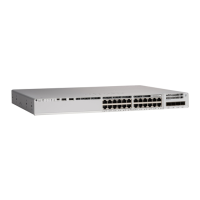83-6
Catalyst 4500 Series Switch, Cisco IOS Software Configuration Guide - Cisco IOS XE 3.9.xE and IOS 15.2(5)Ex
Chapter 83 Configuring Easy Virtual Network
About Easy Virtual Network
Identifying Trunk Interfaces in Display Output
Because a trunk interface carries multiple EVNs, sometimes it is not sufficient to display only the trunk
interface name. When it is necessary to indicate that display output pertains to a particular EVN running
on the trunk interface, the convention used is append a period and the virtual network tag, making the
format interface.virtual-network-tag. Examples are gigabitethernet1/1/1.101 and
gigabitethernet1/1/1.102.
By default, when a trunk interface is configured, all of the EVNs and associated virtual network tags are
configured, and a virtual network subinterface is automatically created. As stated above, a period and
the virtual network tag number are appended to the interface number.
In the following example, VRF red is defined with virtual network tag 3. Hence, the system created Fast
Ethernet 0/0/0.3 (in VRF red).
Device# show running-config vrf red
Building configuration...
Current configuration : 1072 bytes
vrf definition red
vnet tag 3
!
address-family ipv4
exit-address-family
!
You can display this hidden interface with the show derived-config command and see that all of the
commands entered on Fast Ethernet 0/0/0 have been inherited by Fast Ethernet 0/0/0.3:
Device# show derived-config interface fastethernet0/0/0.3
Derived configuration : 478 bytes
!
interface FastEthernet0/0/0.3
description Subinterface for VRF NG red
vrf forwarding red
encapsulation dot1Q 3
ip address 10.1.1.1 255.255.255.0
end
Single IP Address on Trunk Interfaces
A trunk interface can carry traffic for multiple EVNs. To simplify the configuration process, all the
subinterfaces and associated EVNs have the same IP address assigned. In other words, a trunk interface
is identified by the same IP address in different EVN contexts. This is because each EVN has a unique
routing and forwarding table, thereby enabling support for overlapping IP addresses across multiple
EVNs.
Relationship Between VRFs Defined and VRFs Running on a Trunk Interface
By default, the trunk interfaces on a router will carry traffic for all VRFs defined by the vrf definition
command. For example, in the following configuration, every VRF defined on the router is included on
the interface:
interface FastEthernet 1/0/0 vnet trunk ip address 10.1.1.1 255.255.255.0

